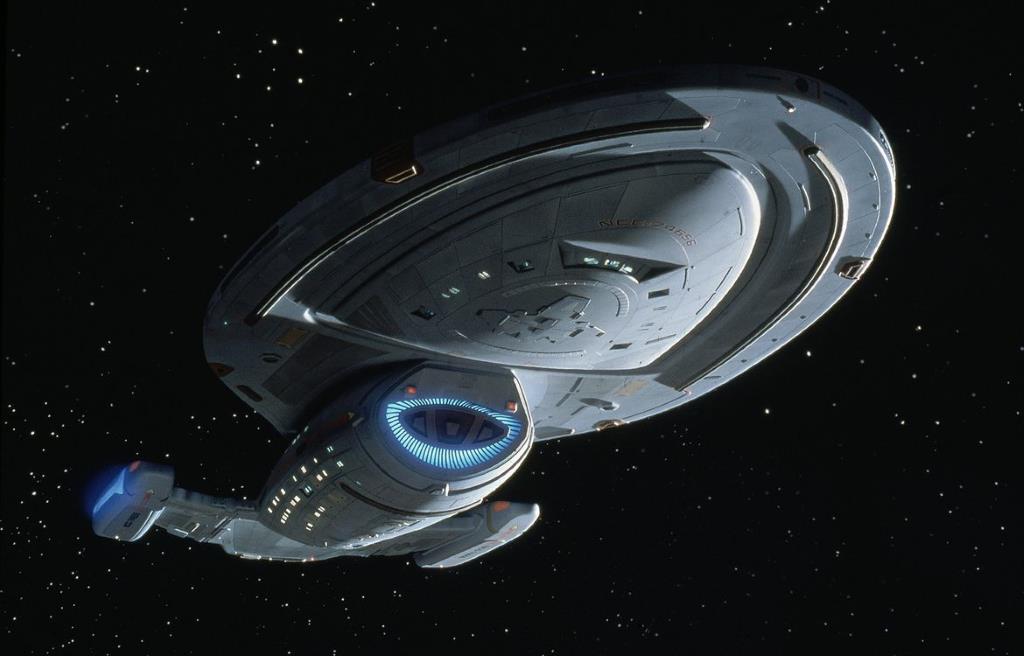U.S.S. VOYAGER NCC-74656


The first Intrepid-class Starship was the U.S.S. Intrepid NX-74630 prototype, which was the 3rd starship named Intrepid. The U.S.S. Voyager, registry NCC-74656 was commissioned in 2371. It was the second of four Intrepid-class starships built by Starfleet at Earth Station McKinley in orbit around Earth. It was designed for research, exploration, and stellar cartography. It is smaller than most Federation starships, but it is much more maneuvarable. (It is approximately half the length of the Sovereign-class starships.) Voyager is also equipped with landing gear and an anti-gravitational system which allows the ship to land on planetary surfaces. The new variable-geometry warp design allows Voyager to sustain higher warp speeds for a longer time, without damaging subspace. Voyager contains a backup warp core in storage. Installation of the backup core requires ventral EVA access and extensive extra-vehicular operation for installation.
Much of the isolinear circuitry has been replaced with bio-neural gel packs. The gel packs speed up system response time by 40%. Voyager is equipped with 48 replaceable gel packs. The Intrepid class starships were the first to use the bio-neural circuitry. The gel packs are susceptable to biological viruses and "infections" which can cause equipment failure until the packs are replaced. The success of the new technology has led Starfleet to adopt it in many of their new starship designs, including the new Akira-class and Sovereign-class starships.
In 2371, U.S.S. Voyager was sent to intercept a Maquis vessel in the Badlands near the Federation-Cardassian border. The ship disappeared and was officially declared lost in 2373.
In 2374, during field tests of the prototype starship U.S.S. Prometheus, the EMH Doctor from U.S.S. Voyager was transferred onto the Prometheus via an alien subspace array located in the Delta Quadrant. The EMH Doctor reported that Voyager was lost in the Delta Quadrant. He was sent back to Voyager through the array with the message that Starfleet was working on a way to get them home and to let them know that they are no longer alone.
In 2375, Lt. Reginald Barclay of the Pathfinder Project at Starfleet Communications Research Center discovered a way to successfully establish temporary two-way communications with U.S.S. Voyager in the Delta Quadrant.
In 2377, U.S.S. Voyager returned to the Alpha Quadrant through a Borg transwarp conduit, destroying the Borg's transwarp hub in the process.
After U.S.S. Voyager was decommissioned, it was retired to Starfleet's Fleet Museum at Athan Prime.
Much of the isolinear circuitry has been replaced with bio-neural gel packs. The gel packs speed up system response time by 40%. Voyager is equipped with 48 replaceable gel packs. The Intrepid class starships were the first to use the bio-neural circuitry. The gel packs are susceptable to biological viruses and "infections" which can cause equipment failure until the packs are replaced. The success of the new technology has led Starfleet to adopt it in many of their new starship designs, including the new Akira-class and Sovereign-class starships.
In 2371, U.S.S. Voyager was sent to intercept a Maquis vessel in the Badlands near the Federation-Cardassian border. The ship disappeared and was officially declared lost in 2373.
In 2374, during field tests of the prototype starship U.S.S. Prometheus, the EMH Doctor from U.S.S. Voyager was transferred onto the Prometheus via an alien subspace array located in the Delta Quadrant. The EMH Doctor reported that Voyager was lost in the Delta Quadrant. He was sent back to Voyager through the array with the message that Starfleet was working on a way to get them home and to let them know that they are no longer alone.
In 2375, Lt. Reginald Barclay of the Pathfinder Project at Starfleet Communications Research Center discovered a way to successfully establish temporary two-way communications with U.S.S. Voyager in the Delta Quadrant.
In 2377, U.S.S. Voyager returned to the Alpha Quadrant through a Borg transwarp conduit, destroying the Borg's transwarp hub in the process.
After U.S.S. Voyager was decommissioned, it was retired to Starfleet's Fleet Museum at Athan Prime.
SPECIFICATIONS
| NAME/REGISTRY | U.S.S. Voyager NCC-74656 |
| CLASSIFICATION | Intrepid-Class Scout |
| YEAR COMMISSIONED | 2370 |
| LENGTH | 344 M |
| WIDTH | 132 M |
| HEIGHT | 65 M |
| WEIGHT | 700,000 MT |
| DECKS | 15 |
| CREW COMPLIMENT | 152 |
| PRIMARY PROPULSION | Class-9 Matter/Antimatter Reactor (warp core). Storage facility for Backup warp core (optional; requires Ventral EVA access). New variable-geometry warp nacelle folding formation prevents subspace damage |
| SECONDARY PROPULSION | 2 Deuterium Fusion Drive motors (impulse engines) |
| WARP FACTOR | 9.6 (Cruise Velocity); 9.8 (12 hours); 9.975 (Max) |
| ARMAMENT | 11 Type-X Phaser Banks; 4 Photon Torpedo Launchers; 32 Photon Torpedoes with Class-VI warheads; 2 Tricobalt explosives |
| COMPUTER CORE | 1 Primary Computer Core with Bio-neural circuitry in replaceable gel packs |
| AUXILIARY CRAFT | 3 Type-VIII Shuttlecraft; 2 Titan-class Assault Shuttles; 1 Delta Flyer auxiliary craft |
NOTABLE INTREPID-CLASS STARSHIPS
| REGISTRY | DESIGNATION | CMD. OFFICER | NOTES |
|---|---|---|---|
| NCC-74600 | U.S.S. Intrepid | Class Prototype; 3rd with name Intrepid; Part of Starfleet Battle Group Omega in 2379 (Star Trek: Nemesis) | |
| NCC-74656 | U.S.S. Voyager | Capt. Kathryn Janeway | Lost in Badlands in 2371; Contacted Starfleet in 2374 ("Caretaker","Message in a Bottle") |
| NCC-74705 | U.S.S. Bellerephon | Adm. William Ross | Admiral Ross' flagship during the Dominion war ("Inter Arma Enim Silent Leges") |
| NCC-75418 | U.S.S. Valiant | Part of Starfleet Battle Group Omega in 2379 (Star Trek: Nemesis) |